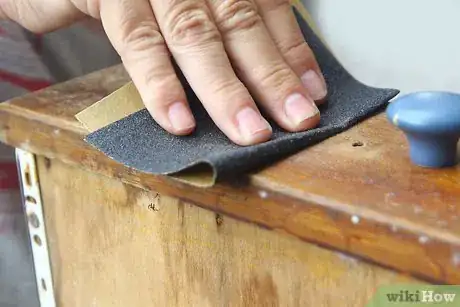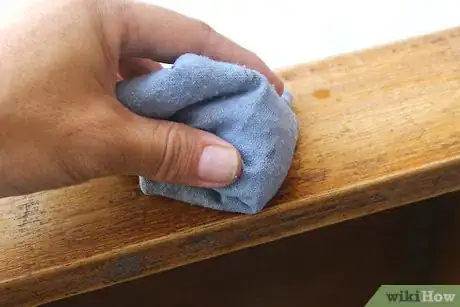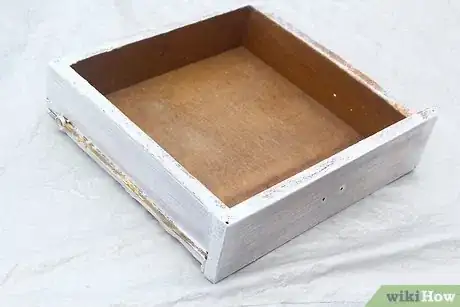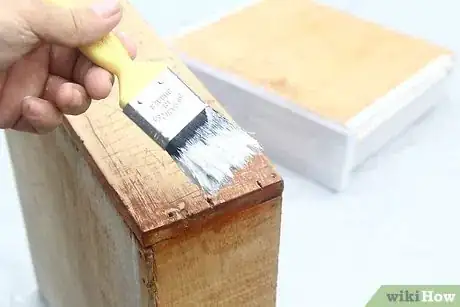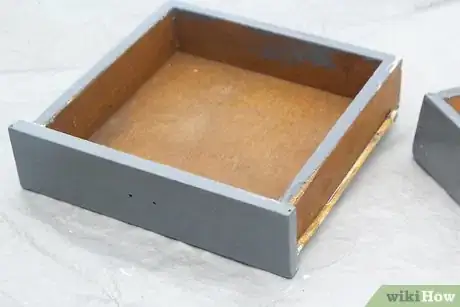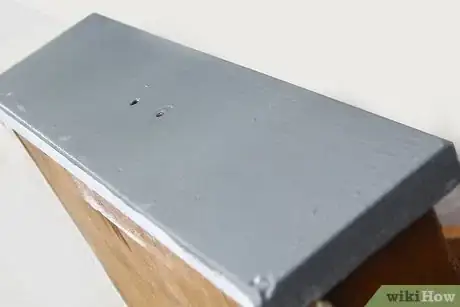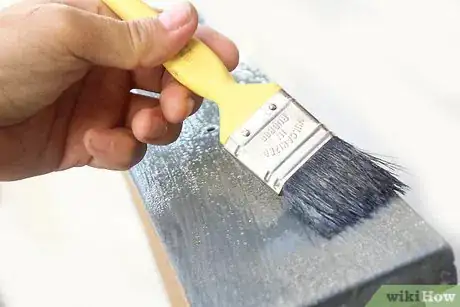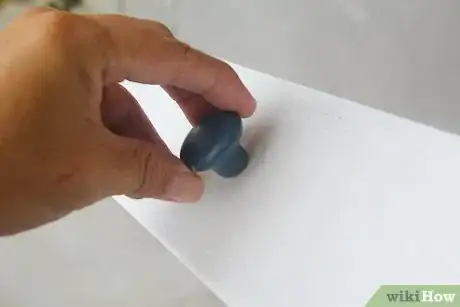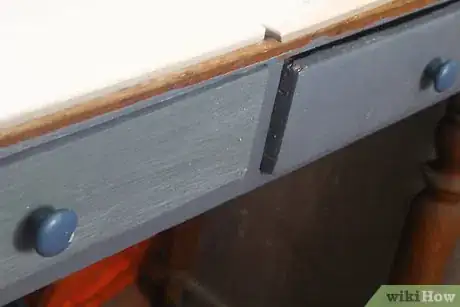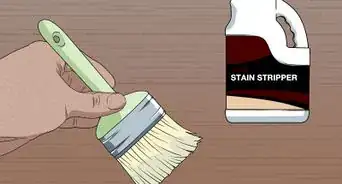This article was co-authored by Patrick Coye. Patrick Coye is the owner and operator of Patrick’s Painting & Home Improvement in Alexandria, Virginia. With over 15 years of experience in residential construction, Patrick specializes in painting, wallpaper removal/installation, drywall, staining decks and fences, and kitchen cabinetry painting. To date, Patrick and his team have painted over 2,000 houses and stained over 800 decks. Patrick's Company won a "Top Job" award from the American Painting contractor magazine in 2020.
There are 13 references cited in this article, which can be found at the bottom of the page.
This article has been viewed 49,228 times.
If you’ve got a dresser or chest of drawers that doesn’t quite match the rest of your home’s decor, don’t throw it out—repaint it! A fresh coat of paint can breathe new life into an old, unflattering piece. Start by sanding the dresser all over to scuff up the existing finish so that it will accept the new paint.[1] Cover the faces and frame with a coat of basic white primer, then brush on your color of choice once it’s had a couple hours to dry. Finally, go over the dresser with a coat of varnish to protect the new paint from chips, scratches, and moisture damage.
Steps
Sanding and Priming the Dresser
-
1Lay down a dropcloth. Sanding, priming, and painting can be messy work, so be sure to stretch out a large dropcloth or plastic tarp over your work area.[2] The extra layer will act as a barrier to protect your floor against spills and splatters.[3]
- Paint fumes can quickly become overpowering. For this reason, it’s recommended that you do your painting in a garage or workshop that will provide some ventilation, or in an outdoor space like a patio or driveway.[4]
- Use strips of tape or heavy objects like paint buckets to hold down the corners of the dropcloth and keep it from blowing around in a stiff breeze.
-
2Remove the drawers from the dresser. Pull out each drawer, lifting them at the opening to help them clear the edge of the roller track. Set these aside on your dropcloth—you’ll be painting them separately from the rest of the frame.[5]
- Clear everything out of the drawers once they’re free to avoid ruining any cherished belongings.
Advertisement -
3Sand the dresser with a medium-grit sandpaper. Use a square of 80-100 grit sandpaper to gently scuff the entire outer surface. This will remove the existing finish so that the dresser will have an easier time accepting fresh paint.[6] Sand with smooth, circular rubbing motions to avoid leaving noticeable streaks in the grain.[7]
- Make sure you give the edges, corners, and any recessed or molded bits some attention, as well.
- Bearing down too hard with the sandpaper may damage the wood underneath.
-
4Wipe down the dresser with a damp cloth. Run the cloth lightly over the sanded surface to collect loose dust and debris. Once the dresser is clean, let it sit for 20-30 minutes to give it time to dry before you move on to priming.[8]
- Any wood dust you miss may show up in the finished paint job.
-
5Brush on a coat of basic white primer. Apply the primer in one thin, even coat using a brush or foam roller. Aim for total coverage—every part of the dresser you intend to paint should be underlaid by a neutral base coat. This will allow the new color to come through clearer and bolder.[9]
-
6Allow the primer to dry for 4-6 hours. The base coat needs to set completely before you can paint over it. To speed the process along, make sure the dresser receives plenty of airflow. Opening a couple doors or windows or setting up a portable fan in front of the piece can help with this.[12]
- Come back periodically and give the primer a tough-test to see how it’s coming along. If it feels sticky, it still needs more time.
- Painting over wet primer can smudge the base coat, leaving behind white swirls in your new color.
Applying Fresh Paint
-
1Use a latex paint formulated for indoor use. Latex paint is one of the best choices for furniture, due to its resilient finish. It has a sleek, chalky look that sits well on top of primer and provides excellent coverage. You’ll get equally attractive results using either an oil or water-based paint.[13]
- A single gallon of paint should be more than enough to redo even the largest dresser or chest of drawers.
- It’s important to keep your layers consistent—don’t use an oil-based paint over a water-based paint or primer, or vice versa.[14]
-
2Roll or brush the first coat of paint onto the dresser. Paint with long, linear strokes from one side of the piece to the other. Complete the faces, frame, and drawers individually. That way, you’ll be able to give each your full attention and avoid oversights and inconsistencies.[15]
- Be sure to stir the paint thoroughly with a stir stick or wooden dowel or to ensure that it’s properly mixed.
- If you’re using a roller, fill a disposable paint tray with just enough paint to cover one side of the dresser at a time. This will keep the rest of the paint from drying out while you work.
-
3Paint the drawers separately. Once you've added a new layer of color to the frame, move onto the individual drawers. Since dresser drawers have so many edges, angles, and curves, it's important to paint every part of them that will be visible when they're open. This includes the sidewalls and backside of the face.[16]
- A handheld brush will give you the most control over where to place a fresh coat of paint.
- Consider painting the entire drawer inside and out to make it look like a more natural fit for the updated dresser.[17]
-
4Give the first coat 2-4 hours to dry. After you’ve covered the entire dresser, you’ll need to give the paint time to begin hardening before you can follow up with a second coat. Leave the piece uncovered and avoid handling it while it’s wet. Exact drying times will vary depending on the type of paint you’re working with, so always refer to the manufacturer’s instructions.[18]
- Keep the doors and windows to your work area shut if it’s raining or especially humid outside. Excess moisture can make drying take longer and even impact the look of the finish.
- For the sake of convenience, it may be easiest to finish up the first coat in the morning and start the second coat in the later afternoon or evening. That way, it will be able to dry overnight.
-
5Layer on additional coats of paint. Allow the first coat to dry completely, then repeat the painting process with a second coat. For a more assertive color, you can even add a third or fourth coat. Keep in mind that each subsequent coat will require 2-4 hours of drying time.[19]
- Go back over every area you painted the first time around, rather than just hitting the broad strokes.
Finishing the Newly-Painted Dresser
-
1Add a coat of protective varnish (optional). After the topcoat has had time to dry, roll or brush on a final clear coat of varnish to seal the new paint. Spread the varnish in a thin, even layer over every surface of the dresser that you painted. Like the other coats, it will need 2-4 hours to dry.[20]
- One of the advantages of latex paint is that it’s smooth enough to offer an eye-catching finish. If you’d prefer something with a little more gloss, however, a clear coat may be just what you need.
- A layer of varnish will also provide protection from minor dings, scratches, and exposure to moisture.[21]
-
2Change out the drawer pulls and other hardware if desired. Now is a good time to replace your dresser’s accessories, since you already have it taken apart. Unscrew the old pieces and dispose of them or store them in labelled bags to reuse later. Attach the updated hardware using all new screws and faceplates for a stronger hold.[22]
- Shop around for attractive knobs, handles, and hinges at your local improvement center, or have a set custom made to suit your unique design sensibilities.
- It may be necessary to patch old holes or drill new ones to accommodate different styles of accessories.[23]
-
3Reassemble the dresser. Slide the drawers back into the dresser and stand back to admire your handiwork. You can put your revamped dresser right back where it was, or find a new place to situate it to change up the layout of your home.[24]
- Check the hardware connections and roller alignment on the underside of the drawers to make sure everything is secure before you call it a day.
Warnings
- Avoid making any single coat of paint too thick. This could create unsightly drips or runs that will noticeable in the dried finish.⧼thumbs_response⧽
Things You'll Need
- Oil or water-based latex paint
- Paintbrush or foam roller
- White oil or water-based primer
- Clear coat varnish
- Medium-grit sandpaper (80-100 grit)
- Screwdriver
- Disposable paint tray
- Updated drawer hardware (optional)
- Dropcloth or tarp
- Painter's tape (optional)
References
- ↑ Patrick Coye. Painting Specialist. Expert Interview. 22 July 2020.
- ↑ Patrick Coye. Painting Specialist. Expert Interview. 22 July 2020.
- ↑ https://thriftdiving.com/how-to-paint-a-dresser/
- ↑ https://thriftdiving.com/how-to-paint-a-dresser/
- ↑ https://www.erinspain.com/how-to-paint-furniture-a-beginners-guide/
- ↑ Patrick Coye. Painting Specialist. Expert Interview. 22 July 2020.
- ↑ https://www.bobvila.com/articles/how-to-refinish-a-dresser/#.WimbSkqnHIU
- ↑ http://www.thefrugalgirl.com/2009/03/how-to-paint-wooden-furniture/
- ↑ https://www.erinspain.com/how-to-paint-furniture-a-beginners-guide/
- ↑ http://www.countryliving.com/remodeling-renovation/home-makeovers/g723/dresser-makeover-0309/?slide=4
- ↑ Patrick Coye. Painting Specialist. Expert Interview. 22 July 2020.
- ↑ https://www.apartmenttherapy.com/how-to-paint-a-wooden-dresser-apartment-therapy-tutorials-178977
- ↑ https://www.erinspain.com/how-to-paint-furniture-a-beginners-guide/
- ↑ https://www.apartmenttherapy.com/how-to-paint-a-wooden-dresser-apartment-therapy-tutorials-178977
- ↑ https://www.apartmenttherapy.com/how-to-paint-a-wooden-dresser-apartment-therapy-tutorials-178977
- ↑ https://inmyownstyle.com/2012/08/how-to-paint-an-old-wood-chest-of-drawers.html
- ↑ https://thriftdiving.com/how-to-paint-a-dresser/
- ↑ https://www.bobvila.com/articles/how-long-does-it-take-paint-to-dry/
- ↑ https://thriftdiving.com/how-to-paint-a-dresser/
- ↑ https://www.apartmenttherapy.com/how-to-paint-a-wooden-dresser-apartment-therapy-tutorials-178977
- ↑ http://www.finewoodworking.com/2007/08/31/refinishing-furniture-step-four-simple-techniques-to-apply-varnish
- ↑ https://www.apartmenttherapy.com/how-to-upgrade-drawer-knobs-pulls-and-handles-220169
- ↑ http://www.bhg.com/kitchen/cabinets/makeovers/how-to-replace-cabinet-hardware/
- ↑ http://www.classyclutter.net/2016/07/how-to-paint-a-dresser/
About This Article
To paint a dresser, cover your work area with a large dropcloth or plastic tarp, pull out all of the dresser drawers, and set them carefully on the dropcloth. Next, sand the dresser frame and drawers with medium-grit sandpaper using circular motions and wipe them down with a damp cloth to remove the sanding dust. Then, add a layer of primer to the frame and drawers and let the primer dry. Finally, use a roller or brush to apply the first coat of paint, let it dry completely, and add the second coat. For tips on adding a protective layer of varnish to your dresser, read on!



